在k8s中,你可以约束一个 Pod 以便限制其只能在特定的节点上运行, 或优先在特定的节点上运行。有几种方法可以实现这点,推荐的方法都是用 标签选择算符来进行选择。 通常这样的约束不是必须的,因为调度器将自动进行合理的放置(比如,将 Pod 分散到节点上, 而不是将 Pod 放置在可用资源不足的节点上等等)。但在某些情况下,你可能需要进一步控制 Pod 被部署到哪个节点。例如,确保 Pod 最终落在连接了 SSD 的机器上, 或者将来自两个不同的服务且有大量通信的 Pod 被放置在同一个可用区。
你可以使用下列方法中的任何一种来选择 Kubernetes 对特定 Pod 的调度:
- 与节点标签匹配的 nodeSelector
- 亲和性与反亲和性
- nodeName 字段
- Pod 拓扑分布约束
环境配置
1 | [root@k8s-master ~]# kubectl get nodes |
nodeName
nodeName:
在 Kubernetes 中,NodeName 是每个 Node 节点的唯一标识符,它是一个字符串,通常是节 点的主机名(hostname)。在创建 Pod 时,可以通过指定 nodeName 字段来将 Pod 调度到特定的 Node 节点上。
指定pod运行在哪个节点上
1 | [root@k8s-master day9]# cat nodename_pod.yaml |
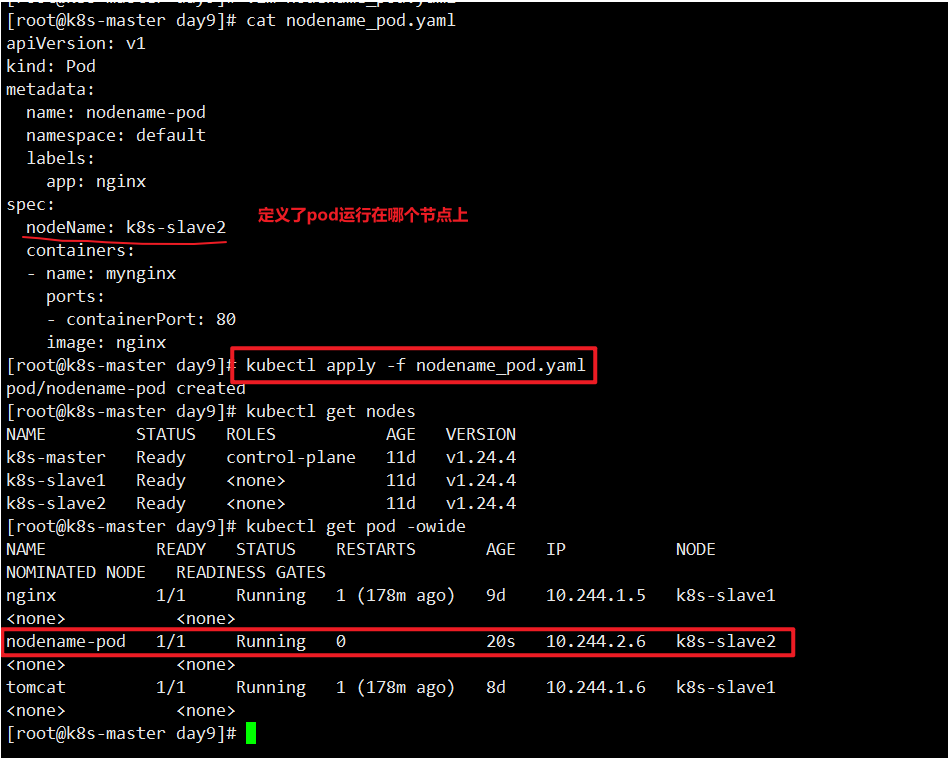
nodeSelector
在 Kubernetes 中,Node 节点选择器(NodeSelector)是用来将 Pod 调度到特定节点的一种机 制。它基于 Node 节点的标签(Node Labels)来进行筛选和匹配,从而使 Pod 能够被分配到满足其要 求的节点上。
具体来说,Node 节点选择器允许用户为 Node 节点打上一组键值对标签,例如: nodeType=compute、diskType=ssd 等等。当用户在创建 Pod 时指定一个或多个 Node Selector 时,Kubernetes 调度器会根据这些选择器的键值对与 Node 节点的标签进行匹配,最终将 Pod 分配到 匹配的节点上。
例如,如果用户定义了一个 Pod 需要一个节点具有标签“nodeType=compute”,那么 Kubernetes 调度器将只会将该 Pod 调度到具有此标签的节点上。如果没有节点具有该标签,则 Pod 将 保持处于 Pending 状态直到有符合条件的节点出现。
例子展示:创建一个pod, nodeSelector选择要带ssd标签的。
1 | root@k8s-master day9]# cat nodeSelector_pod.yaml |

打标签常用命令
1 | #添加标签 |

亲和性 affinity
在 Kubernetes 中,亲和性(Affinity)是一种机制,用于控制 Pod 调度器将 Pod 调度到与其最匹 配的节点上。亲和性机制允许用户定义一组规则,以便将 Pod 调度到具有指定特征的节点上,这些特征 可以是节点的标签(Labels)、污点(Taints)或其他属性。
亲和性有两种类型:节点亲和性(Node Affinity)和 Pod 亲和性(Pod Affinity)。节点亲和性指 定了节点和 Pod 之间的关系,而 Pod 亲和性指定了 Pod 和其他 Pod 之间的关系。
node节点亲和性(Node Affinity)
1 | kubectl explain pod.spec |

1 | kubectl explain pod.spec.affinity |

1 | [root@k8s-master day9]# kubectl explain pod.spec.affinity.nodeAffinity |

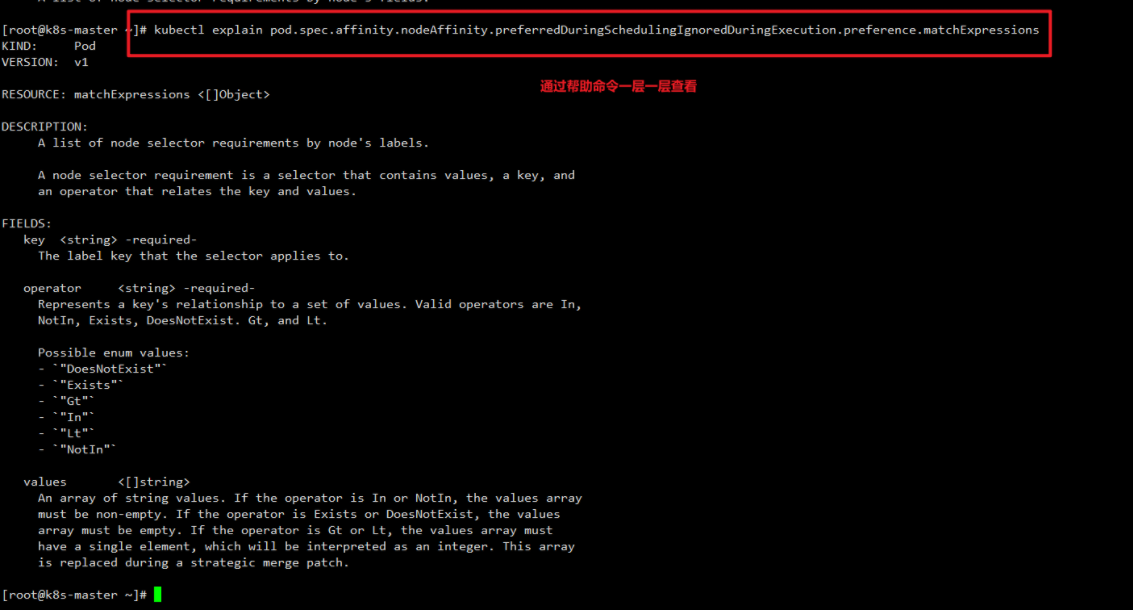
硬亲和性,创建一个案例
1 | [root@k8s-master ~]# cat nodeaffinity.yaml |
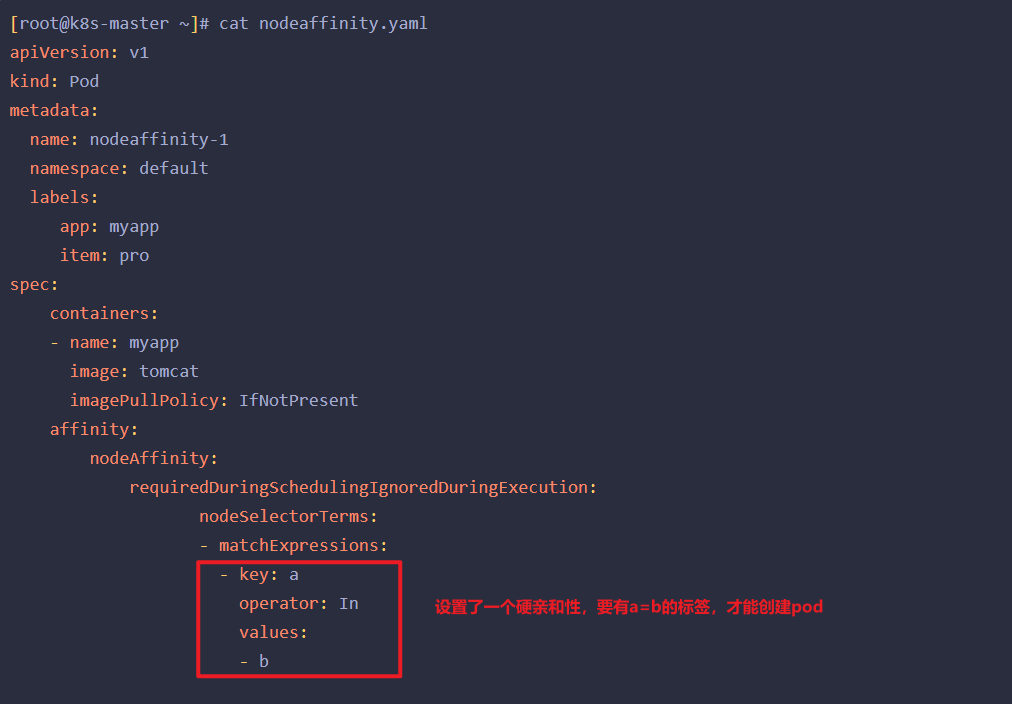
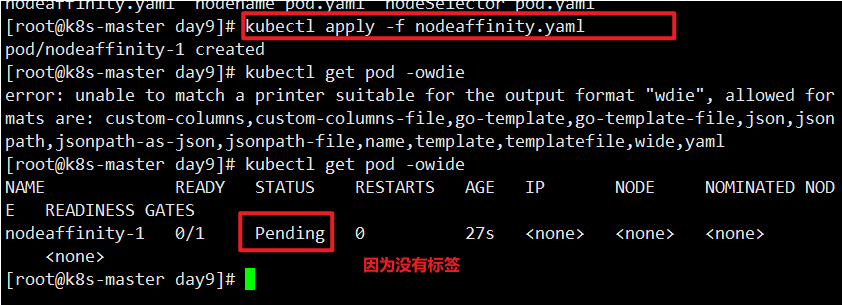
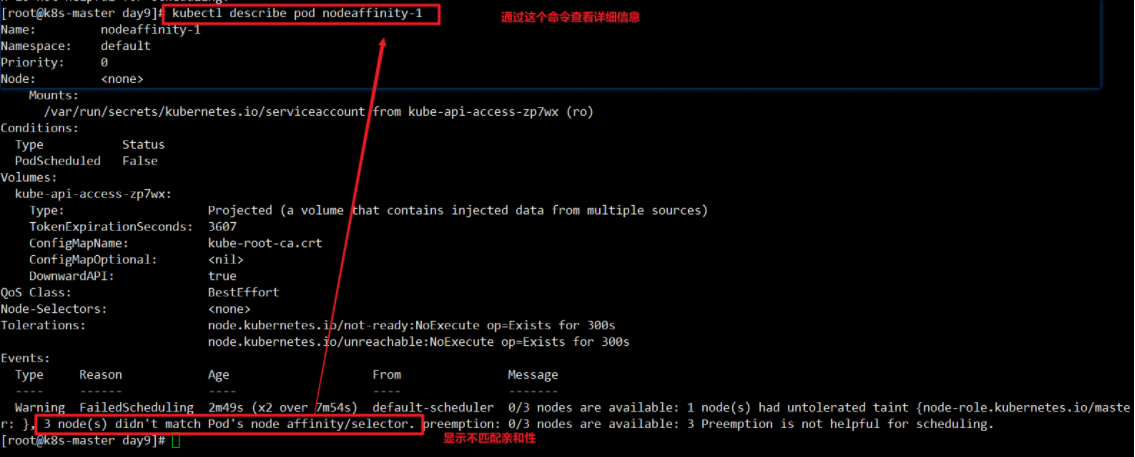
打上一个a=b的标签

软亲和性案例,单个条件
1 | [root@k8s-master day9]# cat nodeaffinity_ruan.yaml |
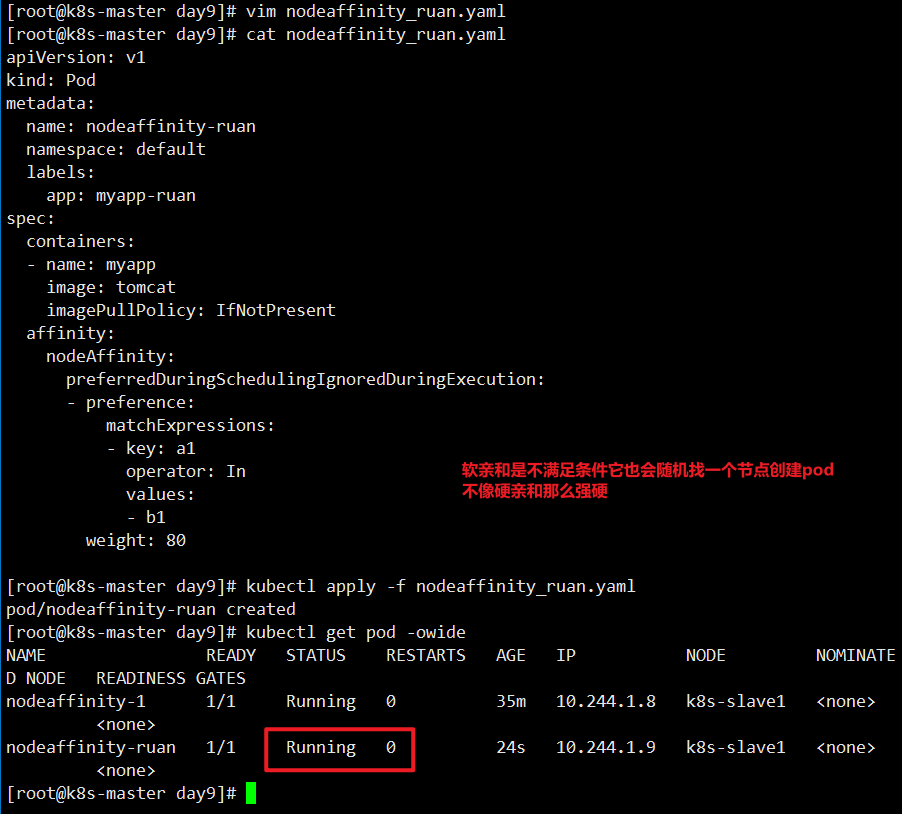
上面说明软亲和性是可以运行这个 pod 的,尽管没有任何一个节点具有 a1=b1 这个标签.
软亲和第二个案例,多个条件
备注:
yaml 文件解释:
使用 weight 字段来指定权重。weight 字段是一个整数值,表示优先级,取值范围为 1 到 100。如果多个节点满足软亲和性的要求,那么 Kubernetes 会根据节点的权重来决定 pod 最终调度的 节点。在这个例子中,weight=80 表示这个软亲和性的优先级为 80。
具体案例分享: 假设我们有一个 Kubernetes 集群,其中有多个节点,每个节点都有不同的标签。现在有一个 Pod,需要运行在 CPU 性能较好的节点上,同时如果有多个节点都满足要求,优先选择具有更多内存的 节点。此时,我们可以使用节点亲和性和软亲和性来指定 Pod 的调度。
首先,我们可以在节点上添加标签,例如,我们可以给性能较好的节点打上 cpu=high 的标签,给 内存较大的节点打上 memory=large 的标签。
其次,我们可以在 Pod 的配置文件中,使用 requiredDuringSchedulingIgnoredDuringExecution 字段来指定硬亲和性,让 Pod 只能调度到具 有 cpu=high 标签的节点上。
最后,我们可以使用 preferredDuringSchedulingIgnoredDuringExecution 字段来指定软亲和 性,同时设置权重值,让 Kubernetes 在有多个节点满足软亲和性时,优先选择具有更多内存的节点。

1 | [root@k8s-master day9]# kubectl get nodes |
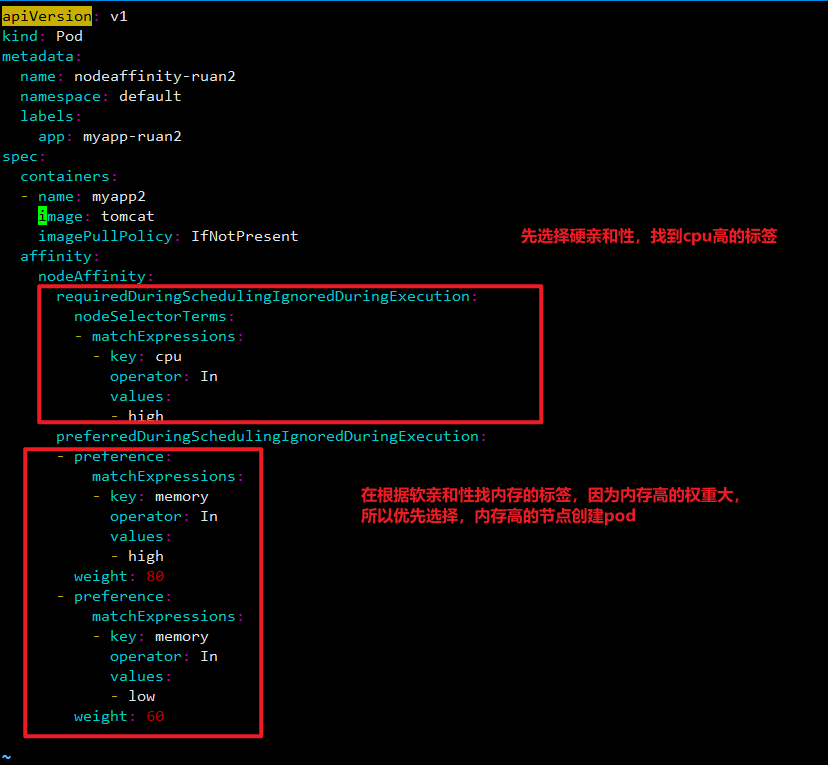
1 | #主机打标签 |
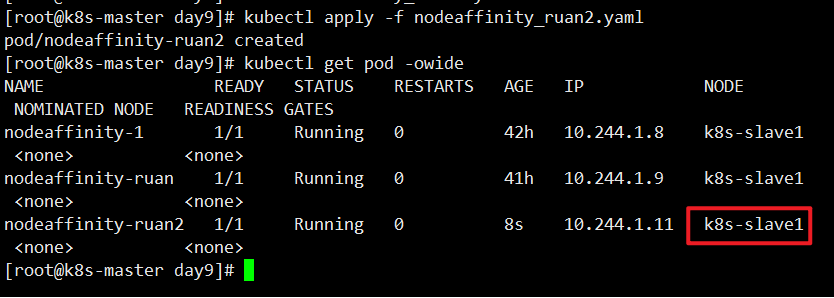
pod 亲和性
Kubernetes 中的 Pod 亲和性可以用来控制将一个 Pod 调度到与其它 Pod 具有特定关系的节点 上。这可以实现多种不同的需求,例如:
• 通过 pod 亲和性提高服务的性能和可靠性:通过将相关服务部署在同一个节点上,可以降低网 络延迟和提高服务响应速度。此外,如果某个节点出现故障,只会影响到部署在该节点上的服 务,不会影响到其它服务。
• 通过 pod 反亲和性分离敏感数据:通过将处理敏感数据的 Pod 与其它 Pod 隔离开来,不调 度到同一个节点上,可以提高系统的安全性。
podAffinity:表示 Pod 与其它 Pod 的亲和性。
可以使用 requiredDuringSchedulingIgnoredDuringExecution、 preferredDuringSchedulingIgnoredDuringExecution
等字段来指定 Pod 与其它 Pod 的亲和性规则。这些字段中可以使用 topologyKey 和 labelSelector 字段来指定 Pod 之间的关系。
pod 亲和性分两种:
podaffinity(pod 亲和性):Pod 亲和性是指一组 Pod 可以被调度到同一节点上,即它们互相吸 引,倾向于被调度在同一台节点上。例如,假设我们有一组具有相同标签的 Pod,通过使用 Pod 亲和性规则,我们可以让它们在同一节点上运行,以获得更高的性能和更好的可靠性。
podunaffinity(pod 反亲和性):Pod 反亲和性是指一组 Pod 不应该被调度到同一节点上,即它 们互相排斥,避免被调度在同一台节点上。例如,如果我们有一组应用程序 Pod,我们可以使用 Pod 反亲和性规则来避免它们被调度到同一节点上,以减少单点故障的风险和提高可靠性。

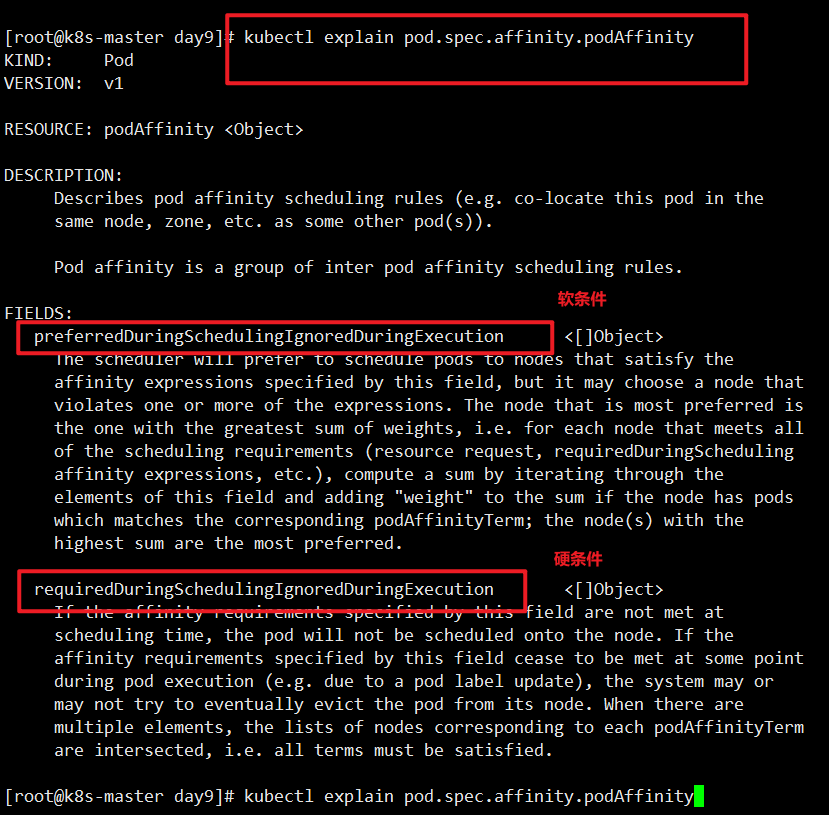
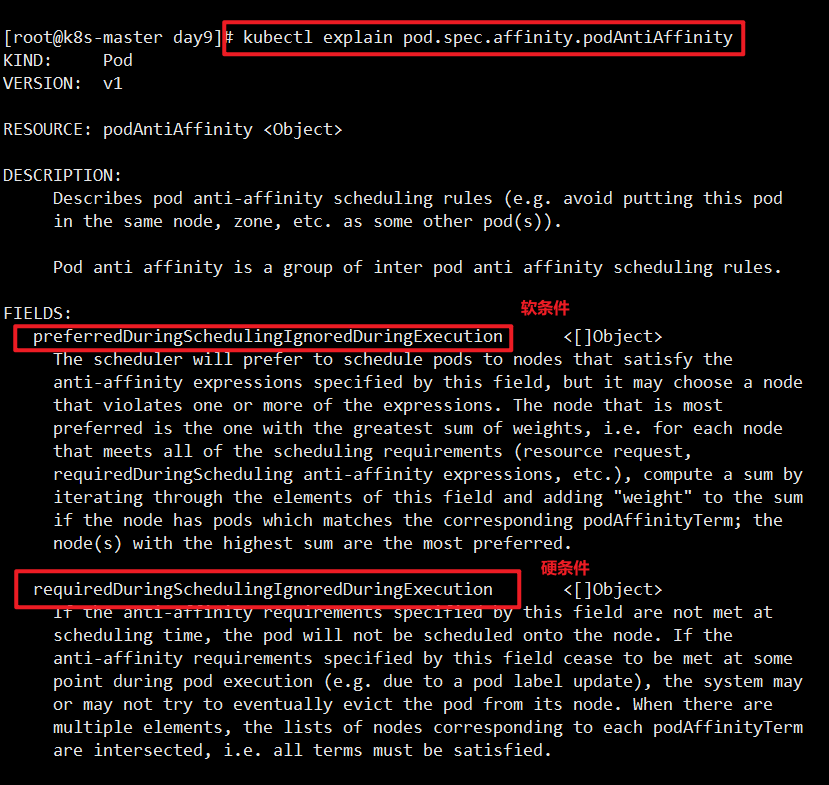
定义两个pod,调度到同一位置
1 | [root@k8s-master day9]# cat podaffinity-require.yaml |
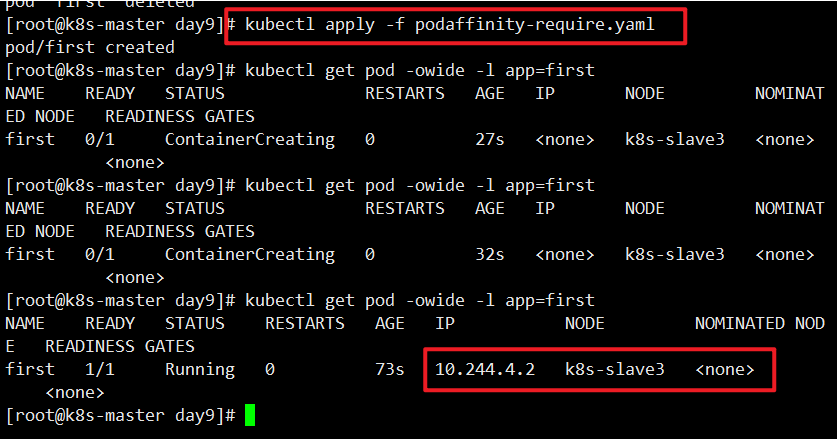
1 | [root@k8s-master day9]# cat podaffinity-require2.yaml |
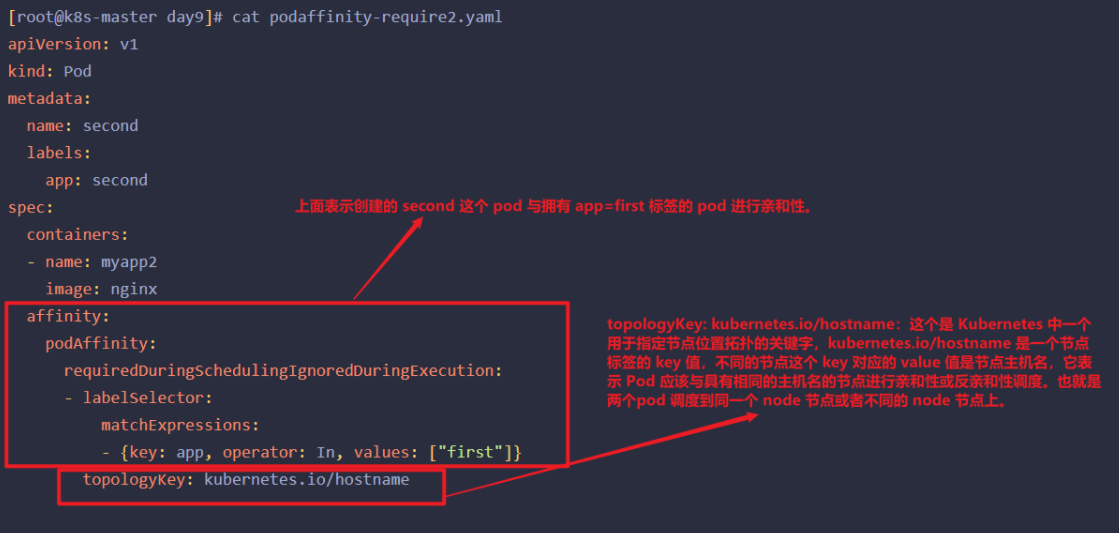


这个案例中,第一个pod调度到哪个节点,第二个pod也会 s调度到同样的节点。
pod反亲和性
定义两个pod,第一个pod做为标准,第二个pod跟它调度到不同的节点上
1 | [root@k8s-master day9]# cat podunaffinity-require.yaml |
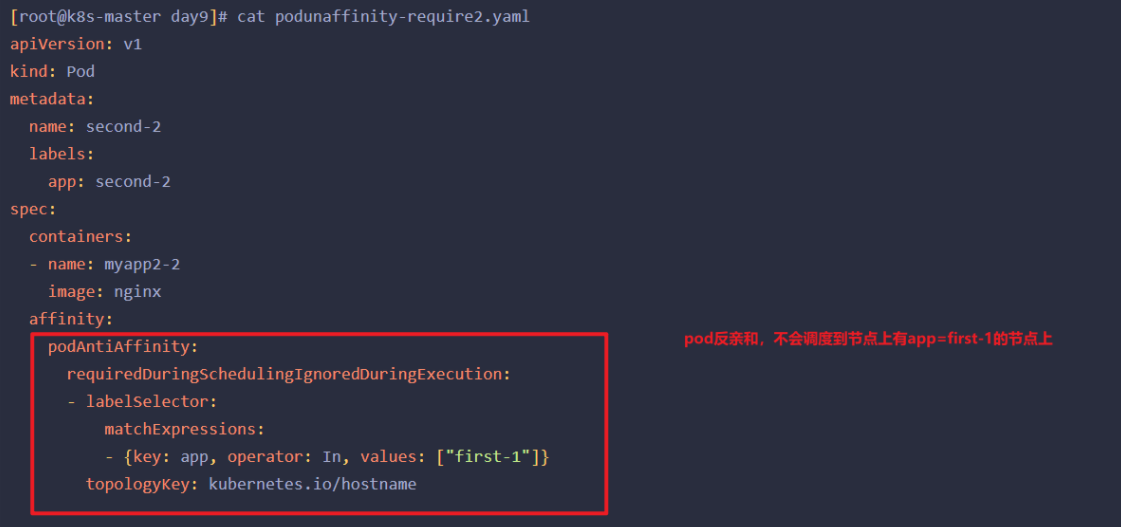
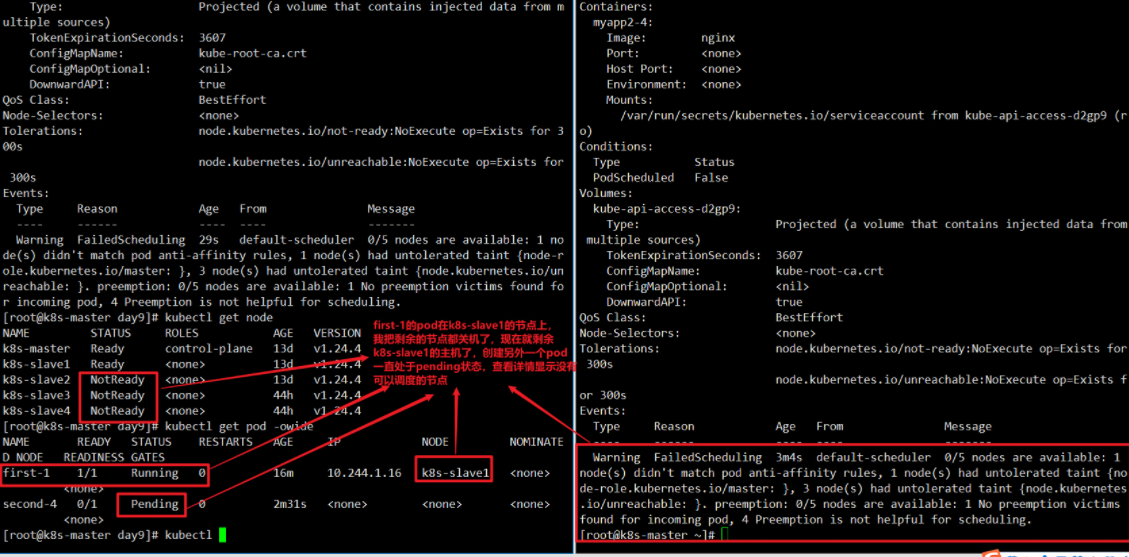

上面的案例就是pod的反亲和性,两个pod不会在一个节点上。
pod高级用法:污点和容忍度
在 k8s 集群中,节点可能会发生各种问题,如资源瓶颈、故障、维护等,这些问题可能会影响节点 上运行的 pod。为了解决这些问题,k8s 提供了污点和容忍度机制。
污点(Taint)是一种节点上的属性,它表示该节点存在某种问题,如磁盘空间不足、内存不足等。 如果一个节点被标记了污点,那么默认情况下,k8s 不会在该节点上调度新的 Pod。这是因为 k8s 希 望确保 Pod 在运行时能够获得足够的资源,并且不会因为节点问题而意外终止。
容忍度(Toleration)是一种 Pod 的属性,容忍度只是告诉 Kubernetes,这个 Pod 可以容忍 特定的污点,但是并不意味着 Pod 必须被调度到拥有这个污点的节点上。实际上,Pod 仍然可以被调度到没有对应污点的节点上。
使用容忍度的主要目的是允许某些 Pod 能够运行在一些不符合正常调度要求的节点上,例如由于节点故障或维护等原因导致节点暂时不可用时,一些 Pod 定义容忍度之后可以被调度到其他节点上,以确保应用程序的高可用性。
假设我们有一个 k8s 集群,其中有两个节点:k8s-slave1 和k8s-slave2。我们想要在 k8s-slave1上运行一个特定的应用程序 Pod,但是 k8s-slave1 节点有一个特定的污点,需要通过容忍度来容忍。
首先,我们给k8s-slave1打一个污点,可以使用一下命令:
1 | [root@k8s-master day9]# kubectl taint node k8s-slave1 a=b:NoSchedule |
这会在 k8s-slave1 节点上打一个名为 a=b 的污点,它的效果是 NoSchedule,意味着新的 Pod 无法被调度到该节点上,除非该 Pod 设置了容忍度。
1 | [root@k8s-master day9]# cat podtaint.yaml |

在刚才的yaml文件定义了一个容忍度规则,它告诉k8s,如果有一个a=b、效果为NoSchedule的污点,则允许被调度到有这个污点的节点上。
1 | 注意! 定义了容忍度,也不代表pod一定会创建在有污点的主机上,它也会调度到没有污点的节点上。 |
定义一个pod,但不定义容忍度,那它肯定不会调度到k8s-slave1节点上。
1 | [root@k8s-master day9]# cat podtaint-1.yaml |
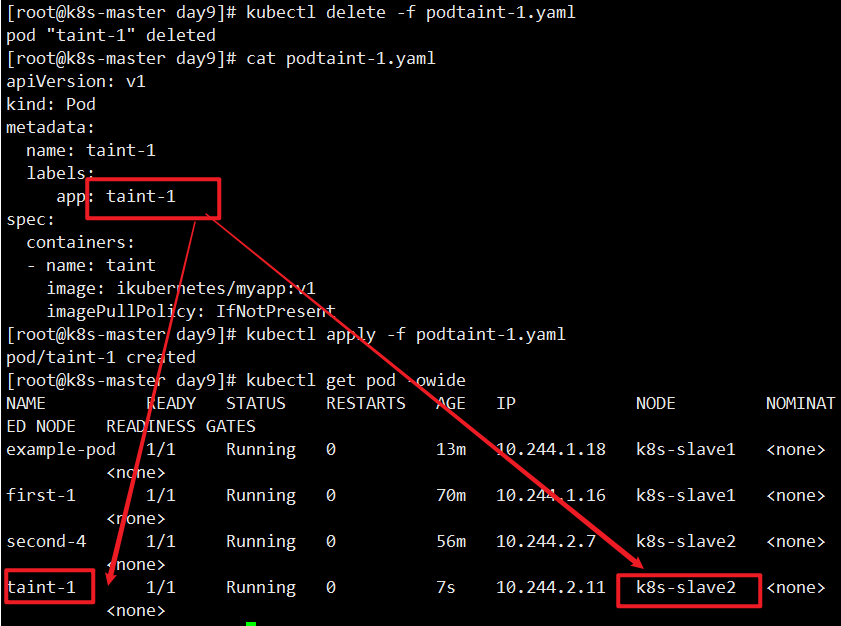
设置污点常用命令
1 | #打污点 |
查看污点如何定义的
1 | [root@k8s-master day9]# kubectl explain node.spec.taints |
node.spec.taints 字段是定义节点上的污点(taints)。每个污点由三个属性组成:key、value 和 effect。
key:污点的名称,可以是任意字符串。在同一节点上,多个污点的 key 不能相同。
value:污点的值,可以是任意字符串,用于进一步标识污点。可以为空字符串。
effect:污点的效果,用于告诉 Kubernetes,哪些 Pod 可以被调度到该节点上。有三种效果可供选择:
NoSchedule:表示新的 Pod 无法被调度到该节点上,但不会影响已有的Pod。
PreferNoSchedule:表示新的 Pod 会尽量不被调度到该节点上,除非没有其它节点可调度。
NoExecute:表示在该节点上运行的现有 Pod,如果不符合污点要求,则会被逐渐终止并移除。
查看pod容忍度如何定义
1 | [root@k8s-master day9]# kubectl explain pods.spec.tolerations |
key:表示污点的键,必须与节点上的污点键相匹配才能容忍此污点。
value:表示污点的值,必须与节点上的污点值相匹配才能容忍此污点。如果未指定,则默认为空字 符串。
operator:表示匹配操作符。可以是 Equal、Exists 。在 Equal 操作符下,如果 key、value 和 effect 都与节点上的污点匹配,则该容忍度规则会被视为匹配。因此,key、value 和 effect 都需要匹配才能算作是匹配的容忍度规则。”Exists” 表示只要节点上存在 key 字段指定的污点,无论其对应 的 value 是什么,都将被视为匹配的容忍度规则。
effect:表示容忍度的作用效果。跟 node 节点上的 effect 匹配即可。
tolerationSeconds:要想在 pod 容忍度中指定 tolerationSeconds 参数,effect 字段必须设置 为 NoExecute 才可以。如果一个节点上出现了被标记为 NoExecute 的污点,所有已经运行在该节点 上的 Pod 不能容忍这个污点,将会被终止并且删除。如果当 pod 定义容忍度时候容忍 node 节点排斥 等级是 Noexecute 污点时,Pod 会等待 tolerationSeconds 指定的时间,如果在这段时间内污点被 删除,则 Pod 将可以继续在该节点上运行。 否则过了这个时间 pod 就被删除了。
案例NoSchedule
再看一个案例,假如 k8s 集群有三个节点,k8s-master 、k8s-slave1、k8s-slave2,k8s-master 默 认是控制节点,把 k8s-slave1和 k8s-slave2 都打污点,测试让 pod 调度到 k8s-slave1 上。
1 | [root@k8s-master day9]# kubectl taint node k8s-slave1 key=value:NoSchedule |
定义pod没有容忍度
1 | [root@k8s-master day9]# cat pod-toleration-1.yaml |

让pod调度到k8s-slave2上
1 | [root@k8s-master day9]# cat pod-toleration-2.yaml |

把之前创建的污点都删除
1 | [root@k8s-master day9]# kubectl taint node k8s-slave1 key- |
案例,演示tolerationSeconds场景
创建一个pod,定义容忍度
1 | [root@k8s-master day9]# cat pod-toleration-3.yaml |
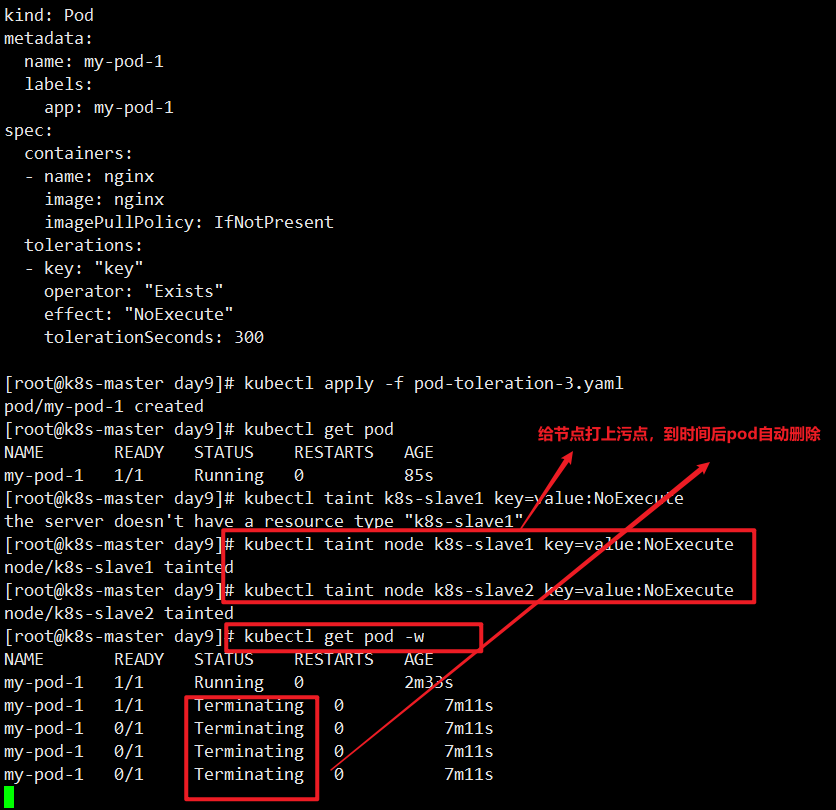
总结
综上,我们可以总结出来 node 节点亲和性、node 节点选择器、node 节点污点分别适用什么场 景:
节点亲和性(Node Affinity)适合用于将 Pod 部署在特定的节点上的场景,比如需要特定硬件 或软件配置的节点,或者需要将某些 Pod 部署在与其他相关服务相同的节点上。通过使用节点亲和性, 可以确保 Pod 在运行时可以获得所需的资源,并提高应用程序的性能和可靠性。
节点选择器(Node Selector)是一种简单的调度策略,它允许在 Pod 中指定一个节点标签,使 得 pod 只能调度到拥有该标签的节点上。如果没有节点满足条件,则该 Pod 无法调度。
污点(Taints)是一种用于标记节点的机制,可以在节点上设置污点来阻止不应该在该节点上运行 的 Pod 调度到该节点上。只有带有相应容忍污点(Tolerations)的 Pod 才能被调度到该节点上。例 如,可以在节点上设置污点来阻止一些敏感应用程序运行在该节点上。
在生产环境中,这些调度策略可以用于以下场景:
节点亲和性:在多节点集群中,通过将某些 Pod 调度到拥有特定硬件或软件配置的节点上,以最大化应用程序性能。例如,可以将需要 GPU 计算能力的机器学习任务调度到拥有 GPU 的节点上,以 提高计算速度。 节点选择器:在多租户环境中,可以使用节点选择器将不同的 Pod 部署在不同的节点上,以隔离 应用程序并避免资源竞争。例如,可以将测试环境的 Pod 调度到专用的测试节点上,而将生产环境的 Pod 调度到专用的生产节点上。 污点和容忍:在生产环境中,可以使用污点和容忍来确保敏感应用程序不会运行在错误的节点上。 例如,可以在拥有机密数据的节点上设置污点,并将只允许在经过身份验证的容器内运行的应用程序的容 忍添加到 Pod 中,以确保敏感数据得到保护。

